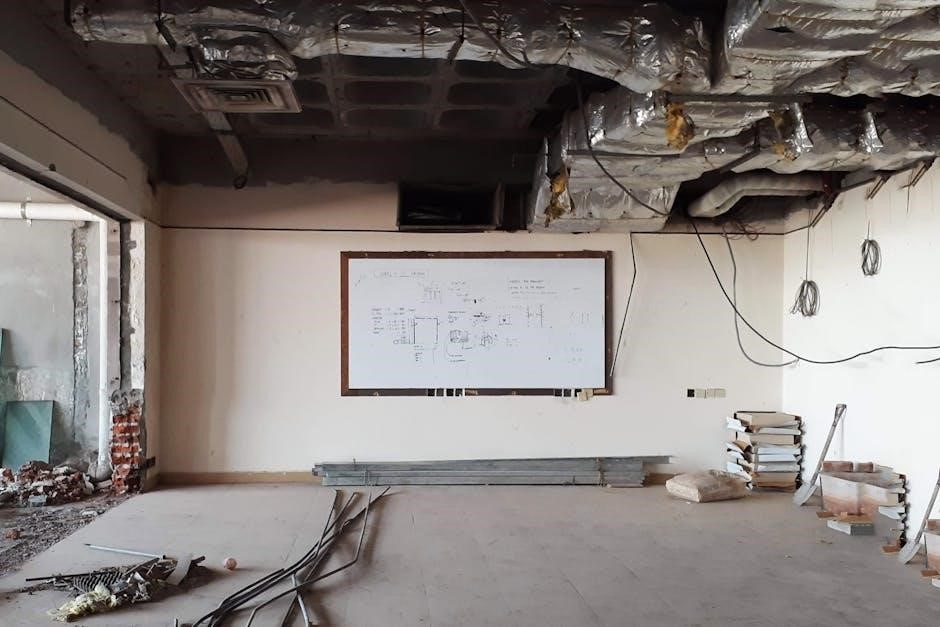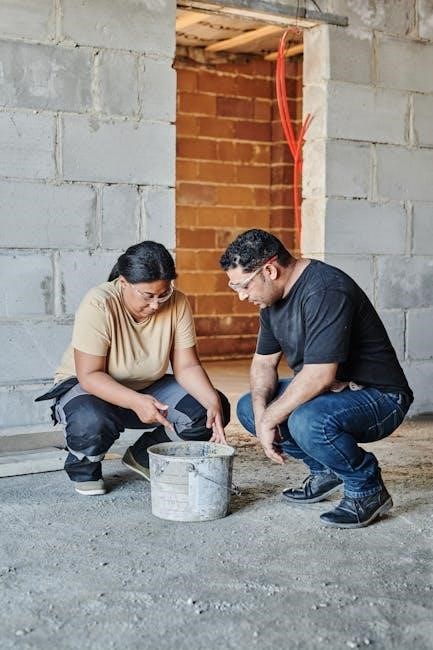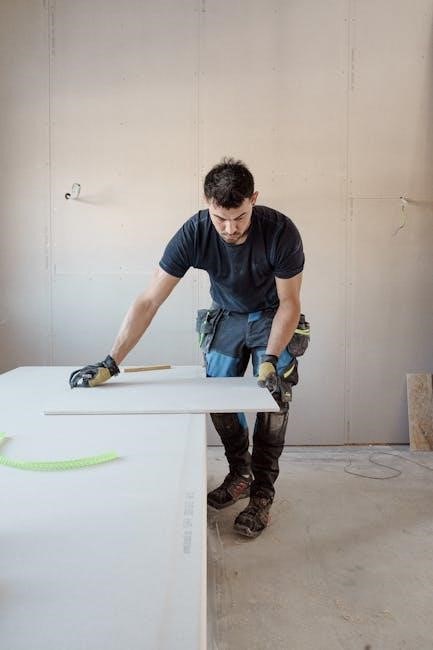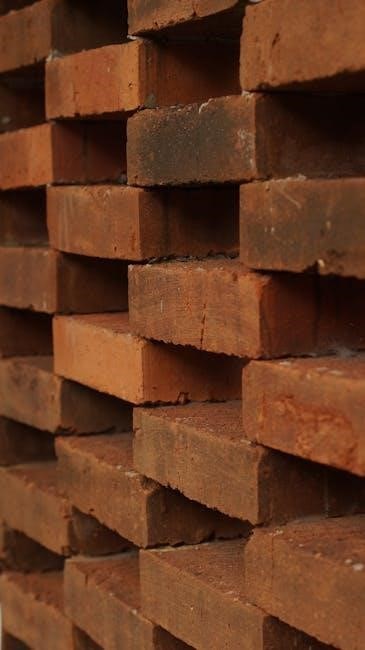The book Fundamentals of Building Construction: Materials and Methods by Edward Allen and Joseph Iano provides a comprehensive overview of construction practices and materials. The 7th edition offers updated insights into modern techniques, sustainability, and structural systems, serving as an essential resource for architects, engineers, and construction professionals.
Overview of Building Construction Fundamentals
Building construction fundamentals encompass the core principles and practices essential for creating structures. This includes understanding materials like wood, steel, masonry, and concrete, as well as construction methods such as framing systems, foundation work, and exterior wall assemblies. The evolution of building techniques has led to modern advancements in structural integrity, sustainability, and energy efficiency. Professionals in architecture, engineering, and construction rely on these fundamentals to ensure safety, durability, and functionality in buildings. The book Fundamentals of Building Construction: Materials and Methods serves as a comprehensive guide, detailing these essential elements for both students and practitioners.
Importance of Materials and Methods in Construction
The selection of appropriate materials and construction methods is critical for ensuring the durability, safety, and sustainability of buildings. High-quality materials ensure structural integrity, while proper construction techniques minimize risks and enhance performance. The choice of materials impacts environmental sustainability, cost, and maintenance requirements. Advanced methods, such as prefabrication and modular construction, improve efficiency and reduce waste. Understanding these principles is vital for meeting building codes, achieving energy efficiency, and delivering projects on time. The synergy between materials and methods ensures that buildings are functional, safe, and adaptable to future needs, making their selection a cornerstone of successful construction projects.

Historical Development of Building Materials and Techniques

The evolution of building materials and techniques traces back to ancient civilizations, where materials like mud, stone, and wood were first used. The Romans introduced concrete, revolutionizing construction with its versatility. The Middle Ages saw advancements in masonry and Gothic techniques, enabling taller structures. The Industrial Revolution brought iron and steel, leading to modern frameworks. The 20th century introduced reinforced concrete and steel framing, enabling skyscrapers. Each era’s innovations built on previous discoveries, shaping today’s construction practices and materials. Understanding this historical progression highlights how humanity has adapted materials and methods to create safer, more durable, and aesthetically pleasing buildings over time.

Common Building Construction Materials
Common building materials include concrete, steel, wood, masonry, and sustainable options. Each material offers unique properties, enabling durability, versatility, and aesthetic design in construction projects globally.
Concrete: Properties and Applications
Concrete is a versatile and widely used construction material, known for its high compressive strength, durability, and affordability. Comprising cement, water, and aggregate, it hardens upon curing, offering excellent structural integrity. Its workability allows casting into various shapes, making it ideal for foundations, walls, floors, and pavements. Concrete’s durability resists weathering and chemical erosion, enhancing longevity in diverse environments. It also supports thermal mass, aiding energy efficiency in buildings. Modern applications include reinforced concrete, precast elements, and decorative finishes, showcasing its adaptability in both functional and aesthetic construction projects. Its strength and sustainability make it a cornerstone in modern building practices.
Masonry: Bricks, Blocks, and Mortar
Masonry is a traditional construction method using bricks, blocks, and mortar to create durable and aesthetically pleasing structures. Bricks, typically made from clay or concrete, are versatile and fire-resistant, while blocks, often larger and hollow, provide excellent thermal insulation. Mortar, a mixture of cement, sand, and water, binds these units together, ensuring strength and weather resistance. Masonry structures are known for their longevity and low maintenance, making them ideal for walls, facades, and load-bearing applications. The combination of bricks, blocks, and mortar offers flexibility in design, from modern to traditional architectures, while maintaining structural integrity and sustainability in various construction projects.
Metals: Steel and Aluminum in Construction
Metals, particularly steel and aluminum, are fundamental in modern construction due to their strength, durability, and versatility. Steel is widely used for structural framing, beams, and reinforcement in concrete, offering high tensile strength and flexibility. Aluminum, lightweight and corrosion-resistant, is ideal for facades, windows, and decorative features. Both metals are recyclable, contributing to sustainability. Steel’s high strength-to-weight ratio makes it suitable for large-span structures, while aluminum’s malleability allows for complex shapes. Despite higher costs and potential corrosion issues, metals remain essential for their reliability and adaptability in achieving innovative and durable building designs, balancing structural integrity with aesthetic appeal in various construction projects.

Wood: Types and Uses in Building Construction
Wood is a natural, versatile, and renewable material widely used in construction. It is categorized into hardwoods (dense and durable) and softwoods (lighter and often used for framing). Hardwoods like oak and maple are ideal for flooring, furniture, and finishes, while softwoods such as pine and spruce are commonly used for structural framing and insulation. Engineered wood products, including plywood and oriented strand board (OSB), offer strength and cost-efficiency for walls and roofs. Wood’s aesthetic appeal, insulation properties, and sustainability make it a popular choice for both traditional and modern construction projects, balancing functionality with environmental considerations in building design and execution.
Sustainable and Alternative Materials
Sustainable and alternative materials are increasingly used in construction to reduce environmental impact. These include recycled metals, bamboo, cross-laminated timber (CLT), and low-carbon concrete. Recycled plastics are being transformed into durable building products, while natural materials like straw bales and hempcrete offer eco-friendly alternatives for insulation and walls. These materials often require less energy to produce and can significantly lower a building’s carbon footprint. Additionally, they promote circularity by reusing waste materials. While some alternatives may face challenges in cost or availability, they align with global efforts to create greener, more energy-efficient structures, making them a critical part of modern sustainable building practices.

Construction Methods and Techniques
Construction methods involve systematic approaches to building, ensuring efficiency, safety, and quality. Techniques range from traditional craftsmanship to advanced technologies, optimizing project execution and outcomes effectively always.
Foundation Work: Basics and Types
Foundation work is the structural base of a building, ensuring stability and durability. It involves site preparation, excavation, and constructing the base using materials like concrete, steel, and masonry. Key types include shallow foundations (pad, strip, and raft) and deep foundations (piles and caissons). The choice depends on soil type, load-bearing capacity, and water table levels. Proper construction ensures even load distribution, preventing structural issues. Regular inspection and maintenance are critical for longevity. Understanding foundation basics is vital for ensuring safety and preventing costly repairs in the future.
Wall Construction: Exterior and Interior Systems
Wall construction involves creating structural and non-structural partitions using materials like concrete, masonry, wood, and steel. Exterior walls are load-bearing, providing structural support and insulation, while interior walls are typically non-load-bearing, focusing on space division and acoustics. Exterior systems often include insulation, weatherproofing, and cladding, such as brick, stucco, or siding. Interior walls may feature drywall, plaster, or paneling for finishes. Proper construction ensures durability, fire resistance, and soundproofing. The choice of materials and techniques depends on building requirements, climate, and design aesthetics, ensuring functionality and safety in both residential and commercial settings while meeting local building codes and standards;
Roofing: Materials and Installation Methods
Roofing systems are critical for protecting buildings from environmental elements while ensuring structural integrity. Common materials include asphalt shingles, clay or concrete tiles, metal roofing, and slate tiles, each offering varying degrees of durability and weather resistance. Installation methods vary by material, with asphalt shingles nailed to underlayment, tiles mortar-set, and metal systems screwed into place. Proper ventilation, insulation, and waterproofing are essential for performance. Material selection depends on climate, budget, and aesthetic preferences. Modern techniques emphasize energy efficiency, with options like reflective coatings or solar panel integration. Adherence to local building codes ensures safety and long-term functionality in residential and commercial applications.
Flooring: Types and Installation Techniques

Flooring systems are essential for comfort, durability, and aesthetics in buildings. Common types include hardwood, tile, carpet, laminate, and concrete, each offering unique benefits. Hardwood provides a natural aesthetic and durability, while tile is versatile and moisture-resistant. Carpet offers sound insulation and warmth, ideal for residential spaces. Installation methods vary: hardwood and laminate use click-lock or adhesive systems, tile requires mortar and grouting, and carpet is stretched or glued. Proper subfloor preparation ensures stability and longevity. Factors like traffic, moisture, and budget influence material choice. Modern techniques emphasize energy efficiency, such as radiant heating systems, and eco-friendly options like bamboo or cork flooring.
Advanced Construction Methods
Advanced construction methods focus on innovation, efficiency, and sustainability. Modular construction involves assembling prefabricated components off-site, reducing construction time and waste. Prefabrication enhances quality control and minimizes site disruptions. 3D printing enables rapid creation of complex structures using materials like concrete or polymers. Lean construction optimizes workflows to reduce waste and improve productivity. Building Information Modeling (BIM) integrates digital tools for precise planning and collaboration. These methods enhance project timelines, budgets, and environmental performance, aligning with modern construction demands for speed, sustainability, and precision.
Sustainability in Building Construction
Sustainability focuses on eco-friendly practices, energy efficiency, and reducing environmental impact through green materials and renewable resources, ensuring constructions balance human needs with ecosystem preservation.
Green Building Materials and Practices
Green building emphasizes the use of sustainable materials like bamboo, recycled steel, and low-VOC paints to minimize environmental impact. Practices include energy-efficient systems, rainwater harvesting, and solar integration. These methods reduce carbon emissions, promote resource conservation, and enhance indoor air quality. Sustainable materials are durable, requiring less maintenance and replacement. Green practices also align with certifications like LEED, encouraging eco-friendly construction. By prioritizing sustainability, green building supports long-term environmental health while offering cost benefits through reduced energy consumption. This approach is vital for creating eco-conscious structures that balance functionality with environmental stewardship.
Energy Efficiency in Construction
Energy efficiency in construction focuses on reducing energy consumption through smart design and technology. Key strategies include proper insulation, high-performance windows, and energy-efficient HVAC systems. Builders use materials with high thermal mass and incorporate passive solar design to optimize natural heating and cooling. Smart technologies like programmable thermostats and automated lighting control further enhance efficiency. Energy-efficient practices not only lower operational costs but also reduce environmental impact. Codes and certifications, such as LEED, promote these standards. By integrating advanced materials and techniques, energy-efficient construction supports sustainable development and long-term cost savings, making buildings more eco-friendly and resilient.
Environmental Impact of Construction Materials
The environmental impact of construction materials is a critical concern, as their extraction, production, and disposal contribute to resource depletion and pollution. Materials like concrete and steel have high embodied energy, leading to significant carbon emissions. Deforestation from timber use and the depletion of natural resources, such as sand for glass production, further exacerbate environmental degradation. Additionally, waste generation during construction and demolition poses challenges for landfills and ecosystems. To mitigate these impacts, sustainable practices like using recycled materials, minimizing waste, and selecting low-carbon alternatives are essential. Responsible material sourcing and lifecycle management are key to reducing construction’s ecological footprint.

LEED Certification and Sustainable Building
LEED (Leadership in Energy and Environmental Design) certification is a globally recognized standard for sustainable building practices. It evaluates buildings based on energy efficiency, water conservation, indoor air quality, and material sustainability. Projects earn points across categories like sustainable sites, water efficiency, and environmental quality, with levels ranging from Certified to Platinum. LEED promotes reduced environmental impact by encouraging the use of recycled materials, renewable energy, and innovative design. Achieving LEED certification not only enhances a building’s market value but also supports healthier environments for occupants and communities. It plays a vital role in driving the adoption of green building practices worldwide.
Structural Systems in Building Construction
Structural systems, including beams, columns, and foundations, ensure buildings bear loads safely. Proper design ensures stability and safety, supporting the entire building’s weight and external forces effectively.
Framing Systems: Wood and Steel
Framing systems are essential for building structural integrity. Wood framing is traditional, cost-effective, and easily customizable, making it ideal for residential projects. Steel framing offers superior strength, durability, and fire resistance, commonly used in commercial and high-rise buildings. Both materials provide excellent load-bearing capacity, but steel is heavier and more expensive. Wood is lightweight and easier to work with, though it may require additional treatments for pest resistance. Modern construction often combines wood and steel for hybrid systems, optimizing performance and cost. Selecting the right framing material depends on the project’s scale, budget, and structural demands, ensuring safety and long-term stability.
Load-Bearing Walls and Their Construction
Load-bearing walls are critical structural elements that support vertical loads from floors, roofs, and other components. Constructed from sturdy materials like concrete, masonry, or steel, these walls are essential for maintaining a building’s stability. They are typically thicker than non-load-bearing walls and often feature reinforcement, such as steel rebar, to enhance strength. Proper construction involves precise alignment, strong mortar joints, and deep footings to distribute weight evenly. Load-bearing walls must adhere to building codes and engineering specifications to ensure safety. Their placement and design are carefully planned to avoid structural weaknesses, making them indispensable in both residential and commercial construction projects.
Structural Integrity and Safety
Structural integrity ensures buildings can withstand external and internal forces, such as gravity, wind, and earthquakes. Safety is achieved through proper design, materials, and construction practices. Load calculations, material strength, and connections are critical to prevent failures. Building codes and standards provide guidelines for ensuring structural reliability. Regular inspections and maintenance help identify potential risks. Safety measures include fire resistance, emergency exits, and stable foundations. Modern engineering techniques, like seismic design, further enhance safety. Balancing aesthetics, functionality, and structural soundness is essential for creating durable and safe buildings that protect occupants and withstand environmental challenges over time.
Modern Structural Design and Engineering
Modern structural design and engineering involve advanced analysis and simulation tools to optimize building performance. Software like ETABS and STAAD.Pro enable precise calculations for load distribution, stress analysis, and material optimization. Performance-based design ensures structures meet specific criteria for safety and functionality. Innovations like seismic-resistant design and high-strength materials enhance durability. Parametric modeling allows for complex geometries and efficient systems. Collaboration between architects and engineers ensures aesthetic and functional integration. Sustainability is integrated through energy-efficient designs and lightweight materials. These advancements ensure structures are resilient, efficient, and adaptable to future challenges, revolutionizing the field of building construction and engineering.

Modern Technologies and Innovations
Modern technologies like BIM, 3D printing, and modular construction revolutionize building processes, enhancing precision, sustainability, and efficiency. Automation and robotics streamline workflows, reducing costs and time.
Building Information Modeling (BIM)
Building Information Modeling (BIM) is a transformative technology in construction, enabling the creation and management of digital representations of buildings. It integrates architectural, structural, and MEP systems into a single platform. BIM enhances collaboration among stakeholders by providing real-time data and improving communication. It allows for precise modeling, clash detection, and cost estimation, reducing errors and waste. BIM also supports sustainable practices by optimizing material usage and energy efficiency. Its adoption has become critical for modern projects, ensuring better planning, execution, and long-term management of buildings. BIM is revolutionizing the industry by streamlining processes and improving overall project outcomes.
3D Printing in Construction
3D printing, or additive manufacturing, is revolutionizing construction by enabling rapid fabrication of complex structures. It involves layering materials like concrete, polymers, or metals to create precise, customized designs. This method reduces construction time, labor costs, and material waste. It also allows for innovative, eco-friendly designs that traditional methods cannot achieve. Applications include printing entire houses, bridges, and structural components. While still emerging, 3D printing offers immense potential for affordable housing, disaster relief, and sustainable building practices. However, challenges like material limitations, scalability, and regulatory frameworks must be addressed to fully harness its potential in the construction industry.
Smart Materials and Their Applications
Smart materials are advanced substances that respond to environmental stimuli, such as temperature, light, or stress, by changing their properties. Examples include shape-memory alloys, self-healing concrete, and thermochromic materials. These materials enhance building efficiency, durability, and sustainability. In construction, they are used for energy-efficient systems, structural health monitoring, and adaptive facades. Self-healing concrete, for instance, repairs cracks autonomously, extending infrastructure lifespan. Thermochromic windows adjust opacity to regulate heat and light, reducing energy consumption. Smart materials enable innovative, responsive, and sustainable building solutions, addressing modern construction challenges and promoting eco-friendly designs for future infrastructure.
Automation and Robotics in Construction
Automation and robotics are revolutionizing the construction industry by enhancing efficiency, precision, and safety. Robotic systems, such as autonomous equipment and drones, streamline tasks like surveying, material handling, and site monitoring. Advanced robots can perform repetitive jobs, like bricklaying or concrete finishing, with high accuracy. Modular construction and prefabrication leverage robotics to assemble components off-site, reducing labor costs and improving quality. These technologies also minimize human exposure to hazardous environments, lowering accident risks. By integrating automation, construction projects achieve faster timelines, reduced waste, and higher consistency, paving the way for modern, scalable, and sustainable building practices.
The evolution of building construction materials and methods continues to shape the industry, emphasizing sustainability, innovation, and efficiency. As technology advances, the future promises smarter, greener, and safer construction practices.
Emerging Trends in Construction Materials
The construction industry is witnessing a surge in innovative materials that prioritize sustainability and performance. Cross-laminated timber (CLT) and insulated concrete forms (ICFs) are gaining popularity for their energy efficiency and reduced environmental impact. Advanced materials like self-healing concrete and graphene-enhanced composites are revolutionizing durability and structural integrity. Additionally, recycled and alternative materials, such as recycled metals and plastic-based aggregates, are being integrated to minimize waste. Bamboo and hemp-based composites offer eco-friendly alternatives to traditional resources. These trends reflect a shift toward greener, smarter, and more resilient building solutions, aligning with global sustainability goals and advancing construction practices.
Future of Construction Methods and Technologies
The future of construction is poised for transformation through cutting-edge technologies and innovative methods. Robotics and automation are streamlining processes, reducing labor costs, and enhancing precision. Modular and prefabricated construction are gaining traction, enabling faster project delivery and minimizing waste. 3D printing is revolutionizing on-site construction, offering customization and sustainability. Advances in building information modeling (BIM) and artificial intelligence (AI) are optimizing project planning and management. Additionally, the adoption of energy-efficient techniques and renewable energy integration is expected to rise, aligning with global sustainability goals. These technologies promise to make construction faster, safer, and more environmentally friendly, shaping the industry’s future.
Final Thoughts on Building Construction Fundamentals
Understanding the fundamentals of building construction materials and methods is crucial for ensuring durability, safety, and functionality in structures. From traditional materials like wood and concrete to modern innovations in steel and sustainable alternatives, each component plays a vital role. The balance between time-tested techniques and cutting-edge technologies defines the evolution of the industry. As construction advances, prioritizing sustainability, efficiency, and innovation will be key to meeting future demands. Professionals must stay informed about emerging trends and best practices to deliver high-quality, resilient, and environmentally conscious buildings. This foundation ensures that construction continues to adapt and thrive in a changing world.

Resources and References
Explore textbooks, online courses, and professional guides for in-depth knowledge on building construction materials and methods, ensuring a comprehensive understanding of industry standards and best practices.
Recommended Textbooks and Guides
For a deep understanding of building construction fundamentals, key textbooks include “Building Construction Illustrated” by Francis Ching and “Fundamentals of Building Construction” by Edward Allen. These resources provide comprehensive insights into materials, methods, and design principles. They are widely regarded as essential for both students and professionals. Additionally, guides like “Construction Materials and Methods” by Donald Watson offer practical knowledge. Many of these texts are available in PDF formats online, making them easily accessible. Consulting multiple sources ensures a well-rounded understanding of the subject matter.
Online Courses and Tutorials
by ETH Zurich provides practical insights. These courses often include video lectures, quizzes, and projects, making learning interactive. They align with topics found in PDF resources, offering structured learning paths. Many are free or affordable, making them accessible to learners worldwide. These tutorials are ideal for professionals and students seeking to enhance their knowledge in construction materials and methods.
Professional Certifications and Training
Professional certifications in building construction enhance expertise and credibility. Certifications like LEED AP (Leadership in Energy and Environmental Design Accredited Professional) and OSHA Certification are highly regarded. Organizations like the American Concrete Institute (ACI) offer specialized certifications for materials testing; Training programs, such as those by the National Center for Construction Education and Research (NCCER), provide hands-on experience. These certifications and trainings align with topics covered in PDF guides on construction fundamentals. They are designed for professionals seeking to advance their skills in materials and methods. Earning these credentials demonstrates a commitment to industry standards and best practices, opening doors to advanced career opportunities.

